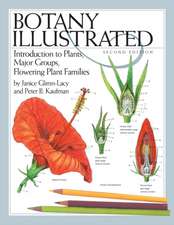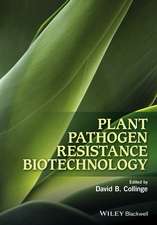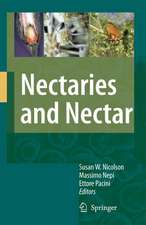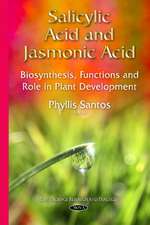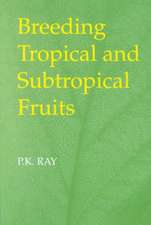Pseudomonas syringae Pathovars and Related Pathogens - Identification, Epidemiology and Genomics
Editat de M’Barek Fatmi, Allan Collmer, Nicola Sante Iacobellis, J. Mansfield, Jesus Murillo, Norman W. Schaad, Matthias Ullrichen Limba Engleză Hardback – 14 aug 2008
| Toate formatele și edițiile | Preț | Express |
|---|---|---|
| Paperback (1) | 1223.88 lei 6-8 săpt. | |
| SPRINGER NETHERLANDS – 19 oct 2010 | 1223.88 lei 6-8 săpt. | |
| Hardback (1) | 1229.10 lei 6-8 săpt. | |
| SPRINGER NETHERLANDS – 14 aug 2008 | 1229.10 lei 6-8 săpt. |
Preț: 1229.10 lei
Preț vechi: 1498.90 lei
-18% Nou
Puncte Express: 1844
Preț estimativ în valută:
235.18€ • 245.57$ • 194.21£
235.18€ • 245.57$ • 194.21£
Carte tipărită la comandă
Livrare economică 15-29 aprilie
Preluare comenzi: 021 569.72.76
Specificații
ISBN-13: 9781402069000
ISBN-10: 1402069006
Pagini: 448
Ilustrații: XI, 433 p.
Dimensiuni: 155 x 235 x 30 mm
Greutate: 0.77 kg
Ediția:2008
Editura: SPRINGER NETHERLANDS
Colecția Springer
Locul publicării:Dordrecht, Netherlands
ISBN-10: 1402069006
Pagini: 448
Ilustrații: XI, 433 p.
Dimensiuni: 155 x 235 x 30 mm
Greutate: 0.77 kg
Ediția:2008
Editura: SPRINGER NETHERLANDS
Colecția Springer
Locul publicării:Dordrecht, Netherlands
Public țintă
ResearchCuprins
Identification and Detection.- Current Technologies for Pseudomonas spp. And Ralstonia solanacearum Detection and Molecular Typing.- Siderophore Uses in Pseudomonas syringae Identification.- Chlorophyll Fluorescence Imaging for Detection of Bean Response to Pseudomonas syringae in Asymptomatic Leaf Areas.- Sensitive Detection of Ralstonia solanacearum Using Serological Methods and Biolog Automated System.- Epidemiology and Disease Management.- Epidemiological Basis for an Efficient Control of Pseudomonas savastanoi pv. savastanoi on Olive Trees.- Pseudomonas syringae pv. syringae on Kiwifruit Plants: Epidemiological Traits and Its Control.- Head Rot of Cauliflower Caused by Pseudomonas fluorescens in Southern Italy.- Internalization and Survival of Pseudomonas corrugata from Flowers to Fruits and Seeds of Tomato Plants.- Copper and Streptomycin Resistance in Pseudomonas Strains Isolated from Pipfruit and Stone Fruit Orchards in New Zealand.- Basal Defence in Arabidopsis Against Pseudomonas syringae pv. phaseolicola: Beyond FLS2?.- Agrobacterium Suppresses P. syringae-Elicited Salicylate Production in Nicotiana tabacum Leaves.- Characterization of an Inhibitory Strain of Pseudomonas syringae pv. syringae with Potential as a Biocontrol Agent for Bacterial Blight on Soybean.- Characterization of the Inhibitory Strain Pantoea sp. 48b/90 with Potential as a Biocontrol Agent for Bacterial Plant Pathogens.- Pseudomonas syringae: Prospects for Its Use as a Weed Biocontrol Agent.- Analysis of Pseudomonas syringae Populations and Identification of Strains as Potential Biocontrol Agents Against Postharvest Rot of Different Fruits.- Pathogenesis and Determinants of Pathogenicity.- The Distribution of Multiple Exopolysaccharides in Pseudomonas syringae Biofilms.- Impact of Temperature on the Regulation of Coronatine Biosynthesis in Pseudomonas syringae.- Role of Flagellin Glycosylation in Bacterial Virulence.- Genetic Relatedness Among the Different Genetic Lineages of Pseudomonas syringae pv. phaseolicola.- WLIP and Analogues of Tolaasin I, Lipodepsipeptides from Pseudomonas reactans and Pseudomonas tolaasii: A Comparison of Their Activity on Natural and Model Membranes.- Competitive Index in Mixed Infection: A Sensitive and Accurate Method to Quantify Growth of Pseudomonas syringae in Different Plants.- Genomics and Molecular Characterization.- Genomic Analysis of Pseudomonas syringae Pathovars: Identification of Virulence Genes and Associated Regulatory Elements Using Pattern-Based Searches and Genome Comparison.- Gene Ontology (GO) for Microbe–Host Interactions and Its Use in Ongoing Annotation of Three Pseudomonas syringae Genomes via the Pseudomonas–Plant Interaction (PPI) Web Site.- Exploring the Functions of Proteins Secreted by the Hrp Type III Secretion System of Pseudomonas syringae.- Conservation of the Pathogenicity Island for Biosynthesis of the Phytotoxin Phaseolotoxin in Pseudomonas syringae Pathovars.- Syringolin A: Action on Plants, Regulation of Biosynthesis and Phylogenetic Occurrence of Structurally Related Compounds.- An RND-Type Multidrug Efflux Pump from Pseudomonas syringae.- Regulation of the Levansucrase Genes from Pseudomonas syringae pv. glycinea at the Level of Transcription.- Evaluation of Phenotypic and Genetic Techniques to Analyze Diversity of Pseudomonas syringae pv. syringae Strains Isolates from Mango Trees.- Characterization of Pseudomonas syringae Strains Isolated from Diseased Horse-chestnut Trees in Belgium.- Interactions of Pseudomonads with Mushrooms and Other Eukaryotic Hosts.- Taxonomy andEvolution.- The Evolution of the Pseudomonads.- Characterization of Pseudomonas savastanoi pv. Savastanoi Strains Collected from Olive Trees in Different Countries.- Separate Origins and Pathogenic Convergence in Pseudomonas avellanae Lineages.- Genetic Diversity Among Pseudomonad Strains Associated with Cereal Diseases in Russian Federation.- Characterization of Antimicrobial and Structural Metabolites from Burkholderia gladioli pv. agaricicola.- Tomato Pith Necrosis Disease Caused by Pseudomonas Species in Turkey.- New Emerging Pathogens.- Emerging Plant Pathogenic Bacteria and Global Warming.- Angular Leaf Spot of Cucurbits: A Bacterial Disease in Expansion in Morocco.- Panicle Sterility and Grain Discolouration: New and Emerging Bacterial Diseases of Rice in Italy.- Pseudomonas Blight of Raspberry in Serbia.- Studies on Plant Pathogenic Bacterium Causal Agent of Soybean Bacterial Spots (Pseudomonas syringaepv. glycinea (Coerper) Young et al.).- Bacterial diseases of Agaricus bisporus in Serbia.
Caracteristici
new methods and approaches for specific and sensitive detection and identification of Pseudomonas syringae and Ralstonia solanacearum ecology and epidemiology bases of Pseudomonas syringae that enable the development of management strategies pathogenesis and determinant of pathogenicity, and in particular, mechanisms involved in virulence and virulence gene expression evolution and diversity of the pseudomonads through multilocus sequence typing (MLST) analysis; determination of pathogens associated with new and emerging diseases effect of global warming on increase and emergence of new bacterial diseases


